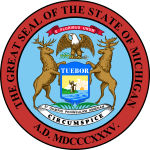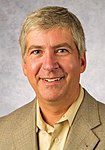| ||||||||||||||||||||
| Turnout | 42.9% | |||||||||||||||||||
|---|---|---|---|---|---|---|---|---|---|---|---|---|---|---|---|---|---|---|---|---|
| ||||||||||||||||||||
Snyder: 40–50% 50–60% 60–70% 70–80% 80–90% >90% Bernero: 40–50% 50–60% 60–70% 70–80% 80–90% >90% Tie: | ||||||||||||||||||||
| ||||||||||||||||||||
| Elections in Michigan |
|---|
 |
The 2010 Michigan gubernatorial election was held on November 2, 2010. Incumbent Democratic governor Jennifer Granholm and lieutenant governor John D. Cherry were prohibited by the state's Constitution from seeking a third term. This resulted in a large pool of candidates which was whittled down, when the May 11 filing deadline passed, to two Democrats and five Republicans.[2] Both the Cook Political Report and the non-partisan Rothenberg Political Report rated the election as leaning Republican.[3][4]
The Republican primary race was highly competitive; both local and national polling reported Congressman Pete Hoekstra, state Attorney General Mike Cox, and businessman Rick Snyder as being front-runners for the Republican Party nomination.[5][6][7][8] The Democratic front-runner when the 2009 polls were conducted, Lieutenant Governor John D. Cherry, withdrew from the race in January 2010.[9][10] The final polls just days before the primary election showed that, while Lansing mayor Virg Bernero was in the lead, over a quarter of those polled were still undecided.[11] The deadline for candidates to file nominating petitions for the August 3 state primary was 4:00 PM on May 11, 2010.[2][12]
A total of 1,575,167 registered voters voted in the primaries, with 66.4% of them voting in the Republican primary.[13] Analysts believe a large portion of Democrats crossed party lines to vote for Snyder, whose ad campaign targeted bipartisan and independent support.[14] In Michigan, voters may vote in either primary regardless of their political affiliation, but can only vote for one party. Ballots with split tickets are not counted in partisan races. Both races came in more disparate than predicted. Snyder won with a near 10-point lead over closest rival Pete Hoekstra, and Bernero won with an even larger 17-point lead over early favorite state house speaker Andy Dillon. Both nominees portrayed themselves as political outsiders.[15] On August 25, Snyder appointed State Representative Brian Calley as his running mate.[16] On August 28, Bernero appointed Southfield Mayor Brenda Lawrence as his running mate.[17]
Snyder won a decisive victory over Bernero in the general election, winning by nearly 20 percentage points. As of 2022[update], this was the last time the counties of Ingham, Marquette, Eaton, Saginaw, Bay, and Muskegon voted for the Republican candidate.
- ^ "General Election Voter Registration/Turnout Statistics". Retrieved October 6, 2019.
- ^ a b "2010 Official Michigan Primary Candidate Listing". Miboecfr.nictusa.com. Retrieved August 21, 2010.
- ^ [1][dead link]
- ^ "The Cook Political Report | The insider's choice for election analysis". Cookpolitical.com. August 17, 2010. Retrieved August 21, 2010.
- ^ "Election 2010: Michigan Governor – Rasmussen Reports". Rasmussenreports.com. August 4, 2010. Retrieved August 21, 2010.
- ^ 1871media.com – [email protected]. "Poll: Cox leads Michigan governor's race". LegalNewsline. Retrieved August 21, 2010.
{{cite web}}: CS1 maint: numeric names: authors list (link) - ^ "Republicans Show Startling Strength in Race for Michigan Governor – Michael Barone". usnews.com. March 19, 2009. Retrieved August 21, 2010.
- ^ "Snyder holds edge in tight GOP governor's race | freep.com | Detroit Free Press". Archived from the original on August 1, 2010. Retrieved July 29, 2010.
- ^ [2] Archived January 8, 2010, at the Wayback Machine
- ^ "John Cherry tells AP he's out of MI race". BostonHerald.com. Associated Press. January 5, 2010. Retrieved August 21, 2010.
- ^ "Poll Bernero opens 8 point lead | WOOD TV8". Woodtv.com. Archived from the original on July 31, 2010. Retrieved August 21, 2010.
- ^ "2010 Important Dates Filing Deadline" (PDF). Retrieved August 21, 2010.
- ^ "2010 Unofficial Michigan Primary Election Results – Governor 4 Year Term (1) Position". Miboecfr.nictusa.com. Archived from the original on December 1, 2012. Retrieved August 21, 2010.
- ^ Berr, Jonathan (August 17, 2010). "Michigan Governor's Race: Will Voters Pick Tough Nerd Rick Snyder or Angry Mayor Virg Bernero?". DailyFinance. Archived from the original on September 18, 2010. Retrieved August 21, 2010.
- ^ "Rick Snyder, Virg Bernero will test voters' opinions on organized labor, outsourcing". AnnArbor.com. August 5, 2010. Retrieved August 12, 2010.
One thing Snyder and Bernero have in common: They're both portraying themselves as outsiders who can solve the political gridlock seizing the state legislature...It's clear voters are tired of politics as usual.
- ^ "It's a go: Rick Snyder names Brian Calley as GOP running mate (video)". MLive Media Group. Michigan. August 25, 2010. Retrieved April 7, 2017.
- ^ [3][dead link]



